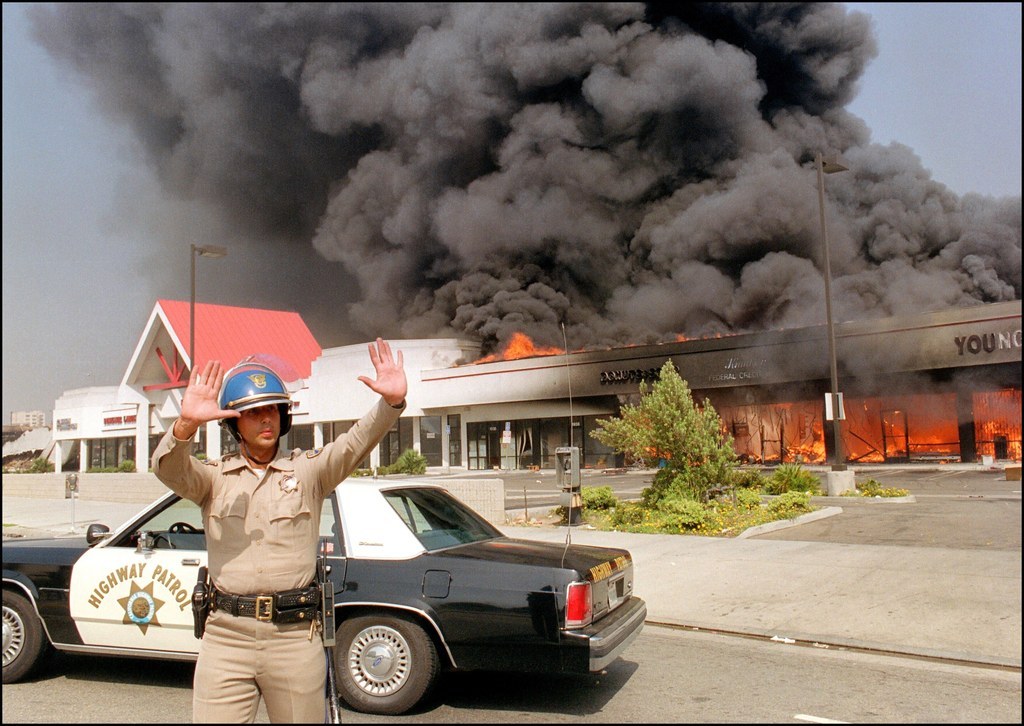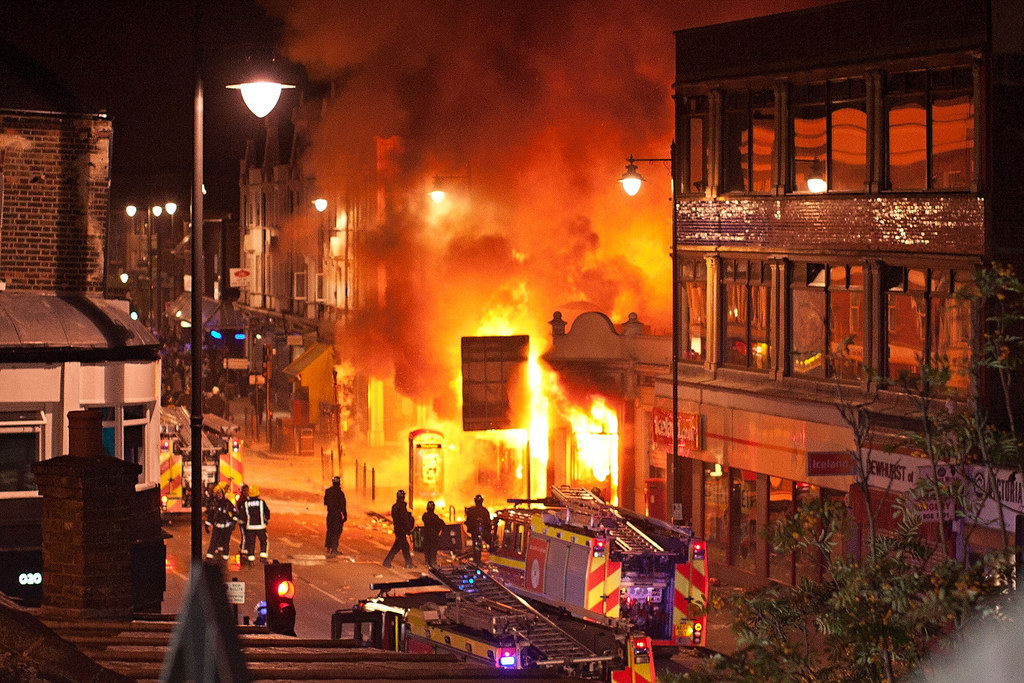
As Edward Ransford, a sociologist at the University of Southern California in Los Angeles, listened to reports from his car radio of the rioting in Baltimore this week, he was transported back to the summer of 1965.
Then a young graduate student at UCLA, Ransford was studying civil rights activism in the city's Watts neighborhood. Ironically, he was interested in why Los Angeles seemed more peaceful than other cities. Then, on Aug. 11, Watts erupted into six days of rioting, looting, and arson. Thirty-four people died, and order was only restored after 4,000 members of the California Army National Guard were put onto the streets.
Ransford quickly adapted his survey questions to ask neighborhood residents about the root causes of the violence. Two-thirds of respondents mentioned long-standing tensions between the police and the local black community — including allegations of frequent excessive force. (The immediate trigger was a dispute that followed the arrest of a black motorist for drunk driving.) Ransford also asked about people's willingness to engage in violent protests, and found that this was linked to political powerlessness: Those who endorsed violence felt that other forms of protest weren't getting anywhere.
This week's Baltimore riots are "so very much like my old 1965 Watts study, in which police tension and perceived brutality were the big things," Ransford told BuzzFeed News.
That study, published in the American Journal of Sociology and in a later book, is one of many sociological studies, journalistic investigations, and official reports to have since explored why riots happen. Although the precise circumstances that cause a city to erupt into violence vary from case to case, these events have a common thread. They usually happen when poor communities with little hope of economic or social advancement are subjected to harsh and discriminatory policing. Economic deprivation alone, without tension between a community and the police, does not seem to spawn riots.
It's a relatively simple lesson that we've seen again and again, from Detroit in 1967, to Los Angeles in 1992, to London in 2011.
In Baltimore, as in Ferguson before it, there's little doubt that aggressive policing helped create the tinderbox that exploded this week. And given that Baltimore — unlike Ferguson — is a city where the mayor, police commissioner, and many police officers are black, it should be clear that it's the system, not the race of those enforcing it, that matters.
Detroit, 1967

Back in the 1960s, such disturbances were known as "race riots." That's why the five days of violence that convulsed Detroit in July of 1967, leaving 43 dead and 2,000 buildings in ruins, had city leaders grasping for an explanation. At the time, Detroit saw itself as a leader in race relations, a liberal counterpoint to attitudes that prevailed in the Deep South.
Perhaps the riots had been led by migrants from the South who were not assimilating well, commentators speculated, or maybe by a disaffected minority who'd fallen off the bottom of the economic ladder. It took a pioneering journalist, who believed in applying scientific methods to answer questions about how society works, to demolish those explanations.
Philip Meyer of the Detroit Free Press devised a questionnaire to test theories of why the riot happened, and sent black interviewers — mostly school teachers — into the affected neighborhoods to gather responses. He found that blacks who grew up in Detroit and other northern cities were more likely to have participated than black migrants from the South, and that college graduates were as likely as high-school dropouts to have gotten involved.
The Detroit Free Press, which won a Pulitzer for its coverage, concluded that the main cause was a pervasive lack of opportunity for advancement in the local black community — even in the face of gains made by the civil rights movement. "The closer you get to an unreached goal, the greater your frustration at not reaching it," Meyer told BuzzFeed News.
The trigger for the riot was a police raid on a late-night drinking den. And the leading explanation given by the black residents interviewed by Meyer's team was "police brutality," mentioned by 57% of them. A year later, when his team surveyed the area again, the proportion citing police brutality as a major complaint had risen to 71%.
Detroit wasn't the only city to see destructive riots in 1967. Newark, New Jersey, had only days before exploded into riots that claimed 26 lives. In response, President Lyndon Johnson established the National Advisory Commission on Civil Disorders, asking its 11 members, led by Otto Kerner, the governor of Illinois, to investigate the causes and recommend how to prevent it happening again.
In February 1968, the Kerner commission issued a report urging drastic action to promote racial integration, create jobs, and improve slum housing. While its recommendations focused mainly on reducing economic inequality, the leading grievance cited in its survey of 24 riots was, once again, the behavior of police.
"[P]olice have come to symbolize white power, white racism and white repression," the report noted. "The atmosphere of hostility and cynicism is reinforced by a widespread belief among Negroes in the existence of police brutality."
Viewed in the light of Baltimore and Ferguson, the Kerner report makes sobering reading. In his evidence to the commission, Kenneth Clark, a psychologist at the City College of New York, known for his studies of racial discrimination, had referred to earlier reports on riots in Chicago in 1919, and Harlem, New York, in 1935 and 1943: "[I]t is a kind of Alice in Wonderland — with the same moving picture re-shown over and over again, the same analysis, the same recommendations, and the same inaction."
Citing Clark's remarks, the Kerner commission concluded: "It is time now to end the destruction and the violence, not only in the streets of the ghetto but in the lives of people."
In most of the country, the Kerner report led to little concrete action. But New York City's liberal Republican mayor, John Lindsay, was the vice chair of the Kerner commission, and had already taken to heart concerns about harsh policing.
After coming to power in 1966, Lindsay instituted strict limits on police use of force, and made sure they were followed through a strong chain of command. He and members of his administration also became fixtures on the streets of Harlem and other neighborhoods, consulting with community leaders. "There were people out there every night, building relationships," Lindsay's former chief of staff, Jay Kriegel, told BuzzFeed News.
When Martin Luther King was assassinated, in April 1968, violence erupted in many American cities. But as the New York Times noted in Lindsay's obituary:
"[W]hen riots tore at Detroit, Newark, Los Angeles and other cities, he walked the steamy night streets of Harlem and other black areas, tie askew, jacket flung over the shoulder, taller than anyone else, talking to people with only a detective at his side: a calm figure of civic dignity. And while other cities burned, New York had only minimal looting and violence."
Los Angeles, 1992

In Los Angeles, it took the riots of 1992 to bring about changes to police strategy. This time the trigger was the failure of a mostly white jury to convict police officers who were caught on video beating a black motorist, Rodney King, after a high-speed pursuit. Fifty-three people died, and more than 1,000 buildings were destroyed.
While there are still tensions between the Los Angeles Police Department and residents of South Los Angeles — especially after the police shooting of a mentally ill black man, Ezell Ford, in August 2014 — the situation has improved from the simmering resentment that prevailed in 1992. "There's been a real shift here to community policing," Manuel Pastor, a sociologist at the University of Southern California who studied the 1992 riots and their aftermath, told BuzzFeed News.
So why haven't these lessons been applied more widely? One problem is that cities with small police departments often lack the manpower to engage effectively with the community. But political will is crucial, Cathy Schneider, a sociologist at American University in Washington, D.C., and author of Police Power and Race Riots: Urban Unrest in Paris and New York, told BuzzFeed News.
Local politicians are frequently elected on a platform of being tough on crime, Schneider said. "If they get elected on that basis, they want police to show big arrest rates. How do you get big arrest rates? You target poor, vulnerable communities."
London, 2011

In the U.S., those communities are overwhelmingly black. But recent experience in Britain has shown that similar dynamics can play out when the divisions are not along such clear racial lines.
In August 2011, rioting broke out across London and in five other British cities, after the police shooting of a young black man, Mark Duggan. Inspired by Meyer's example in Detroit, journalists at The Guardian teamed up with researchers at the London School of Economics (LSE) to find out why the rioters had participated. Those who took part in the violence came from diverse racial backgrounds, and 37% of those who appeared in court charged with riot-related offenses were white.
"The 2011 British riots were in part about policing, and the shooting of Mark Duggan was very much the trigger," criminologist Tim Newburn, who led the LSE team, told BuzzFeed News. "What really came to surface was perceived disenfranchisement that both young black and white people felt in modern British society."
At a conference held to discuss the LSE/Guardian report in December 2011, Conservative Home Secretary Theresa May, the Cabinet minister responsible for policing, announced a review of police "stop and search," mentioned by many rioters as a major source of their resentment. A later report, which came out in 2013, concluded that searches too often lacked justification, with only 9% leading to arrests. Overuse of these powers "threatens the legitimacy of the police," the report warned.
Top-down pressure on British police to reform has continued, with a 2014 follow-up chastising slow progress: "Too many police leaders and officers still don't seem to understand the impact that the use of powers to stop and search people can have on the lives of many, especially young people." London's Metropolitan Police seems to have got the message, however. Its latest statistics show that the number of stop-and-searches dropped by almost half, from 22,194 in March of 2014 to 11,983 in March of 2015.
In the U.S., which has some 18,000 state and local law enforcement agencies, it's much harder to enact widespread change. And too often, according to American University sociologist Schneider, change only comes to a city after it is devastated by rioting. "If we don't respond to police violence unless communities erupt, then communities will erupt," she said.
Theresa May is the Cabinet minister responsible for policing. An earlier version of this story overstated her role in criminal justice policy.

